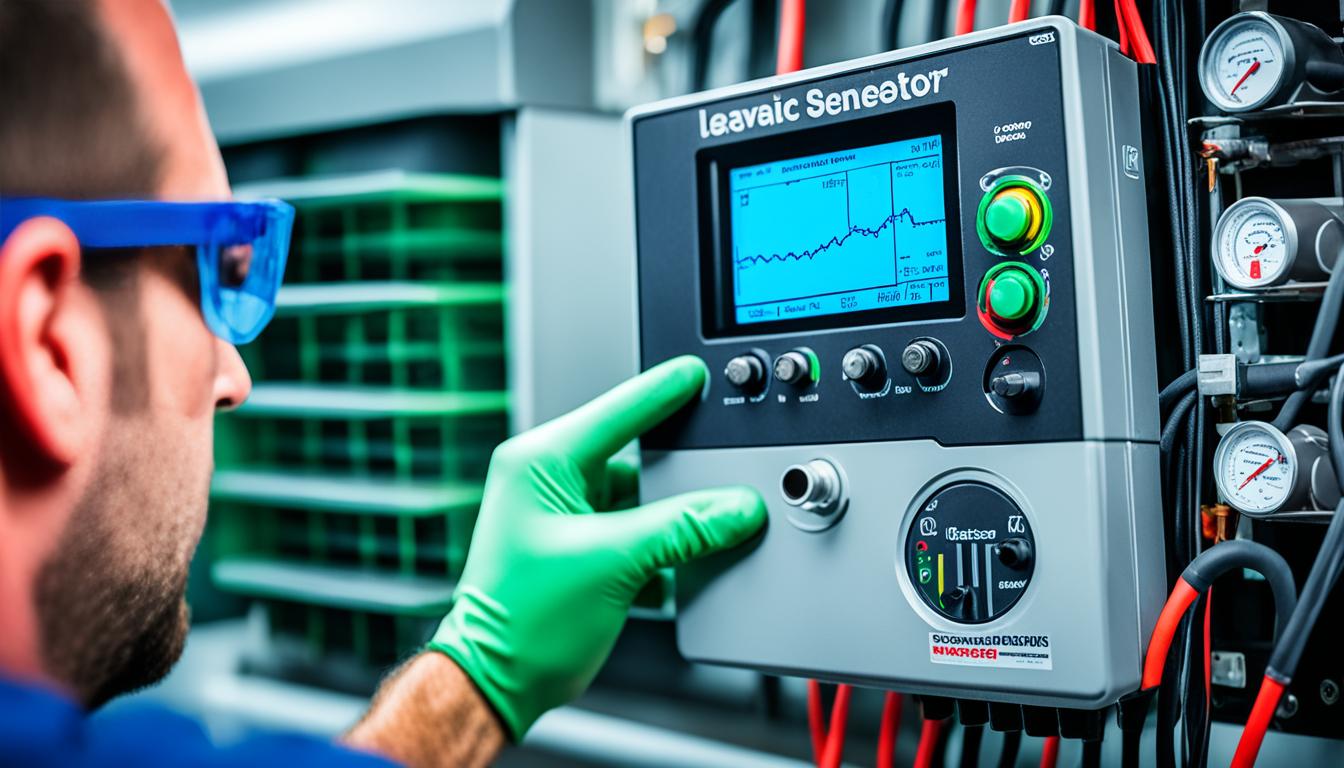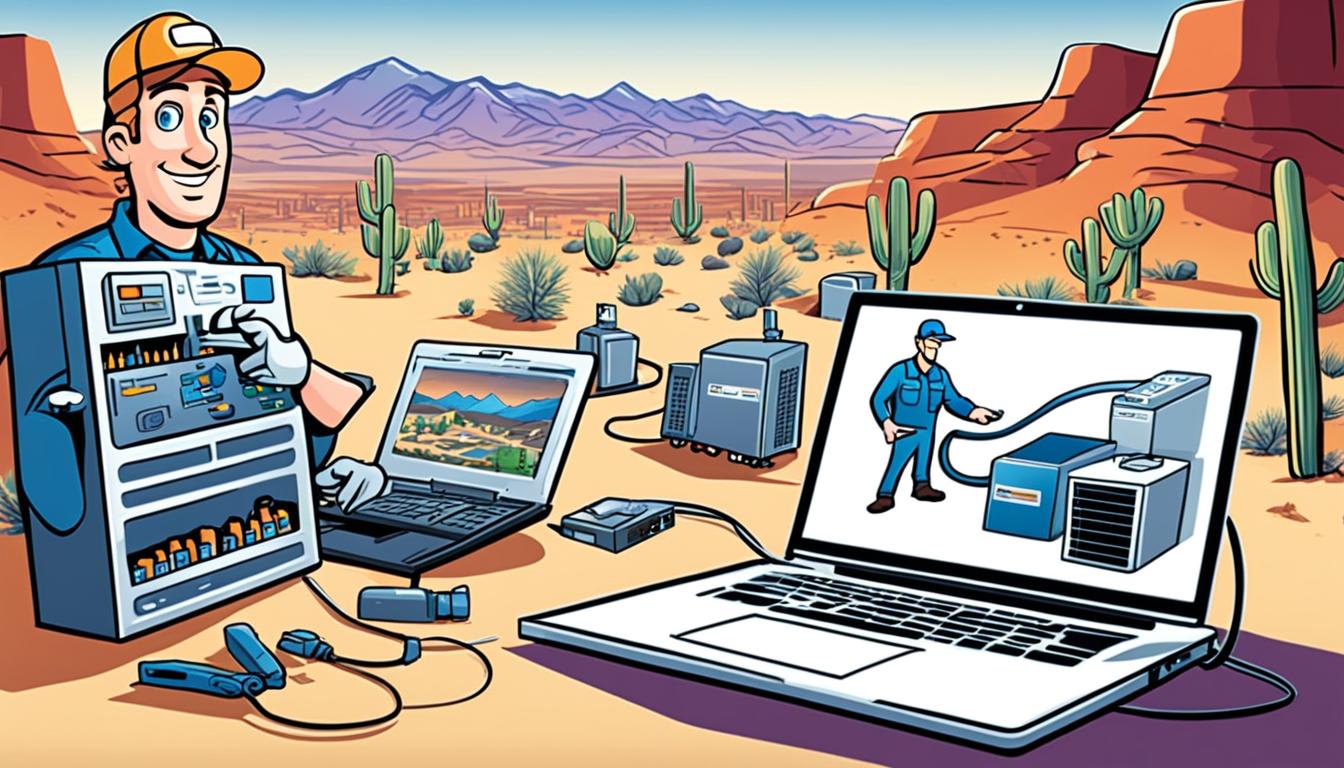Have you ever found yourself faced with a perplexing HVAC system issue that seems impossible to solve? You’re not alone. As an AC repair contractor, I’ve encountered countless instances where troubleshooting complex problems took hours, if not days, of frustrating trial and error.
But everything changed when I discovered the power of AC leak detectors. These remarkable tools have revolutionized the way HVAC contractors identify and resolve issues in cooling systems. With their help, I’ve been able to save time, reduce callbacks, and provide my clients with efficient and reliable HVAC solutions.
Today, I want to share with you the incredible impact AC leak detectors can have on your HVAC troubleshooting process. Whether you’re struggling with reduced cooling capabilities, safety hazards, or simply want to streamline your repairs, these detectors are an absolute game-changer.
Key Takeaways:
- AC leak detectors are essential tools for HVAC contractors when troubleshooting complex system issues.
- These detectors help identify refrigerant leaks that can impact cooling capabilities and pose safety hazards.
- Various types of leak detectors, such as electronic, ultrasonic, and halide torch detectors, are available.
- Each type has its advantages and considerations, contributing to improved diagnostics and efficient repairs.
- By utilizing AC leak detectors, contractors can pinpoint and resolve HVAC issues accurately for optimal system performance and improved efficiency.
The Role of Electronic Leak Detectors in HVAC System Diagnostics
Electronic leak detectors play a crucial role in effectively diagnosing and troubleshooting issues in HVAC systems. These detectors utilize advanced technologies such as negative corona discharge and thermal diode to detect refrigerant leaks with precision. By incorporating electronic leak detectors into your diagnostic process, you can swiftly identify the presence of leaks and address them promptly, improving system performance and reducing potential safety hazards.
One of the key advantages of electronic leak detectors is their ability to create an alarm when refrigerant is detected. This alarm serves as an immediate indication of a leak, allowing HVAC contractors to pinpoint the source and start the repair process. However, it is important to note that certain older models of electronic leak detectors may produce false alarms, which can lead to unnecessary repairs.
To overcome the limitations of older electronic leak detectors, newer technologies such as ultrasonic leak detectors have been developed. Ultrasonic detectors are insensitive to gases and can accurately measure refrigerant levels. This enables contractors to identify leaks more accurately and avoid false alarms, ultimately improving diagnostic efficiency and reducing repair costs. Additionally, ultrasonic detectors are non-invasive and can detect leaks in hard-to-reach areas, enhancing their overall effectiveness in HVAC system diagnostics.
Another method of leak detection that can complement electronic leak detectors is refrigerant bubble detection. This method involves utilizing the bubble method or fluorescent dye kits to visually identify leaks. The bubble method involves applying a solution to the suspected leak area and observing for the formation of bubbles, indicating the presence of a leak. Fluorescent dye kits work by adding a fluorescent dye to the refrigerant, which becomes visible under UV light when there is a leak.
By combining the use of electronic leak detectors with refrigerant bubble detection methods, HVAC contractors can enhance their diagnostic capabilities and ensure comprehensive leak detection. Each type of leak detector has its advantages and considerations, and choosing the most suitable method depends on the specific HVAC system and the nature of the issue at hand.
Comparison between Electronic Leak Detectors and Ultrasonic Detectors
| Electronic Leak Detectors | Ultrasonic Detectors |
|---|---|
| Utilizes negative corona discharge or thermal diode technology | Insensitive to gases and can accurately measure refrigerant levels |
| May produce false alarms | Avoids false alarms, improving diagnostic efficiency |
| Can be invasive and require direct contact with potential leak areas | Non-invasive and capable of detecting leaks in hard-to-reach areas |
| Provides immediate indication of a leak through an alarm | Accurately measures refrigerant levels, reducing the need for trial and error |
The table above highlights the main differences between electronic leak detectors and ultrasonic detectors. While electronic leak detectors offer immediate leak detection with the potential for false alarms, ultrasonic detectors provide accurate measurements without being affected by gas interference. The choice between the two depends on the specific requirements of the HVAC system being diagnosed.
The Environmental Impacts of Refrigerant Leaks and How Leak Detectors Can Help
Refrigerant leaks pose significant environmental risks, contributing to global warming and the depletion of the ozone layer. These leaks release harmful greenhouse gases into the atmosphere, exacerbating climate change and endangering the delicate balance of our planet. Fortunately, leak detectors are powerful tools in the fight against these environmental impacts, enabling prompt identification and repair of leaks.
By utilizing leak detectors in HVAC systems, contractors can play a crucial role in minimizing the release of refrigerants into the atmosphere. This not only preserves the ozone layer but also reduces greenhouse gas emissions, mitigating the harmful effects of global warming. Regularly inspecting and maintaining HVAC systems with leak detectors not only helps protect the environment but also ensures the overall efficiency and longevity of the equipment.
Investing in high-quality leak detectors is not just an expense; it is an investment in the future sustainability of our planet. These detectors enable contractors to conserve refrigerant, reduce energy consumption, and ultimately contribute to environmental preservation efforts. By being proactive in detecting and repairing leaks, you are making a significant impact in safeguarding our environment for future generations.





0 Comments